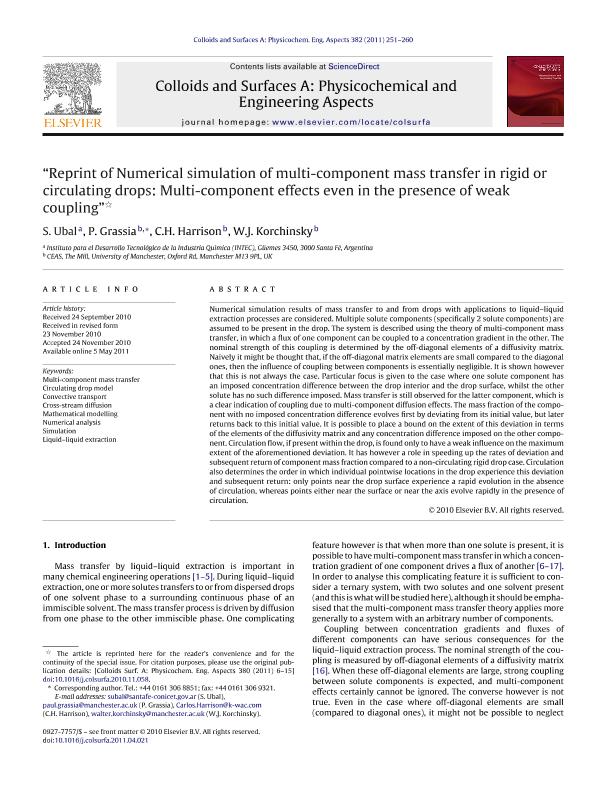Mostrar el registro sencillo del ítem
dc.contributor.author
Ubal, Sebastian

dc.contributor.author
Grassia, Paul Sebastian

dc.contributor.author
Harrison, Carlos
dc.contributor.author
Korchinsky, Walter
dc.date.available
2017-02-14T20:11:08Z
dc.date.issued
2011-05
dc.identifier.citation
Ubal, Sebastian; Grassia, Paul Sebastian; Harrison, Carlos; Korchinsky, Walter; Reprint of Numerical simulation of multi-component mass transfer in rigid or circulating drops: Multi-component effects even in the presence of weak coupling; Elsevier Science; Colloids And Surfaces A: Physicochemical And Engineering Aspects; 382; 1-3; 5-2011; 251–260
dc.identifier.issn
0927-7757
dc.identifier.uri
http://hdl.handle.net/11336/12999
dc.description.abstract
Numerical simulation results of mass transfer to and from drops with applications to liquid–liquid extraction processes are considered. Multiple solute components (specifically 2 solute components) are assumed to be present in the drop. The system is described using the theory of multi-component mass transfer, in which a flux of one component can be coupled to a concentration gradient in the other. The nominal strength of this coupling is determined by the off-diagonal elements of a diffusivity matrix. Naively it might be thought that, if the off-diagonal matrix elements are small compared to the diagonal ones, then the influence of coupling between components is essentially negligible. It is shown however that this is not always the case. Particular focus is given to the case where one solute component has an imposed concentration difference between the drop interior and the drop surface, whilst the other solute has no such difference imposed. Mass transfer is still observed for the latter component, which is a clear indication of coupling due to multi-component diffusion effects. The mass fraction of the component with no imposed concentration difference evolves first by deviating from its initial value, but later returns back to this initial value. It is possible to place a bound on the extent of this deviation in terms of the elements of the diffusivity matrix and any concentration difference imposed on the other component. Circulation flow, if present within the drop, is found only to have a weak influence on the maximum extent of the aforementioned deviation. It has however a role in speeding up the rates of deviation and subsequent return of component mass fraction compared to a non-circulating rigid drop case. Circulation also determines the order in which individual pointwise locations in the drop experience this deviation and subsequent return: only points near the drop surface experience a rapid evolution in the absence of circulation, whereas points either near the surface or near the axis evolve rapidly in the presence of circulation.
dc.format
application/pdf
dc.language.iso
eng
dc.publisher
Elsevier Science

dc.rights
info:eu-repo/semantics/openAccess
dc.rights.uri
https://creativecommons.org/licenses/by-nc-nd/2.5/ar/
dc.subject
Multi-Component Mass Transfer
dc.subject
Circulating Drop Model
dc.subject
Convective Transport
dc.subject
Cross-Stream Diffusion
dc.subject
Mathematical Modelling
dc.subject
Numerical Analysis
dc.subject
Simulation
dc.subject
Liquid-Liquid Extraction
dc.subject.classification
Ingeniería de Procesos Químicos

dc.subject.classification
Ingeniería Química

dc.subject.classification
INGENIERÍAS Y TECNOLOGÍAS

dc.title
Reprint of Numerical simulation of multi-component mass transfer in rigid or circulating drops: Multi-component effects even in the presence of weak coupling
dc.type
info:eu-repo/semantics/article
dc.type
info:ar-repo/semantics/artículo
dc.type
info:eu-repo/semantics/publishedVersion
dc.date.updated
2017-02-09T13:51:49Z
dc.journal.volume
382
dc.journal.number
1-3
dc.journal.pagination
251–260
dc.journal.pais
Países Bajos

dc.journal.ciudad
Amsterdam
dc.description.fil
Fil: Ubal, Sebastian. Consejo Nacional de Investigaciones Científicas y Técnicas. Centro Científico Tecnológico Santa Fe. Instituto de Desarrollo Tecnológico para la Industria Química (i); Argentina
dc.description.fil
Fil: Grassia, Paul Sebastian. University Of Manchester; Reino Unido
dc.description.fil
Fil: Harrison, Carlos. University Of Manchester; Reino Unido
dc.description.fil
Fil: Korchinsky, Walter. University Of Manchester; Reino Unido
dc.journal.title
Colloids And Surfaces A: Physicochemical And Engineering Aspects

dc.relation.alternativeid
info:eu-repo/semantics/altIdentifier/url/http://www.sciencedirect.com/science/article/pii/S0927775711002809
dc.relation.alternativeid
info:eu-repo/semantics/altIdentifier/doi/http://dx.doi.org/10.1016/j.colsurfa.2011.04.021
Archivos asociados
